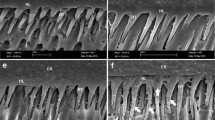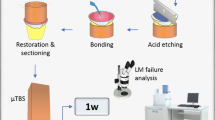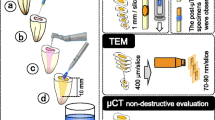Abstract
Objectives
The aims of this study were to evaluate the nanohardness and Young’s modulus of the adhesive-dentin interface and to correlate them with the microtensile bond strength (μTBS) after storage in water for 24 h and 6 months.
Methods
Eighty human third molar teeth were bonded to composite resin with the Adper Scotchbond Multipurpose (SBMP), Adper Single Bond 2 (SB2), Clearfil SE Bond (CSE) or Clearfil S3 Bond (CS3) adhesive systems and stored in water for 24 h and 6 months. Three bonded teeth were selected for each group for nanoindentation methodology to obtain the nanohardness and modulus values (n = 3), while seven bonded teeth each group were used for μTBS (n = 7). Data were analyzed by two-way ANOVA and Tukey’s test (α = 0.05). Spearman correlation between nanohardness and modulus and μTBS values was also calculated.
Results
Nanohardness and Young’s modulus values for the dentin and hybrid layer were not significantly different regardless of the adhesive system or water storage periods (p > 0.05). Nanohardness and Young’s modulus values for the adhesive layer were significantly higher for SB2 than for SBMP, CSE, and CS3 systems in both water storage periods. The μTBS values for SBMP and CSE were significantly higher than for SB2 and CS3 in both storage periods. An inverse correlation between Young’s modulus and μTBS was observed for the adhesive layer.
Conclusion
The water storage periods did not alter nanohardness, Young’s modulus, and μTBS of adhesives. The adhesive layer of SB2 showed the highest nanohardness and Young’s modulus, but the highest dentin bond strength was obtained with SBMP and CSE. Thus, a lower Young’s modulus yielded high bond strength.
Clinical relevance
The inverse correlation between the Young’s modulus of adhesive systems and dentin bond strength suggests adequate resistance of the adhesive to elastic deformation under stress, which are important properties to predict the success of the dental restoration.


Similar content being viewed by others
References
Aizawa K, Kameyama A, Kato J, Oda Y, Hirai Y (2008) Nano-hardness of adhesive interface between Er:YAG laser-irradiated dentin and 4-META/MMA-TBB resin. Photomed Laser Surg 26:107–111
Angker L, Swain MV (2006) Nanoindentation: application to dental hard tissue investigations. J Mater Res 21:1893–1905
Borges BC, Souza-Junior EJ, Brandt WC, Loguercio AD, Montes MA, Puppin-Rontani RM, et al. (2012) Degree of conversion of simplified contemporary adhesive systems as influenced by extended air-activated or passive solvent volatilization modes. Oper Dent 37:246–252
Carvalho RM, Pegoraro TA, Tay FR, Pegoraro LF, Silva NR, Pashley DH (2004) Adhesive permeability affects coupling of resin cements that utilise self-etching primers to dentine. J Dent 32:55–65
De Munck J, Van Meerbeek B, Satoshi I, Vargas M, Yoshida Y, Armstrong S, et al. (2003) Microtensile bond strengths of one- and two-step self-etch adhesives to bur-cut enamel and dentin. Am J Dent 16:414–420
Dos Santos PH, Karol S, Bedran-Russo AK (2011) Long-term nano-mechanical properties of biomodified dentin-resin interface components. J Biomech 44:1691–1694
dos Santos PH, Karol S, Bedran-Russo AK (2011) Nanomechanical properties of biochemically modified dentin bonded interfaces. J Oral Rehabil 38:541–546
Faria-e-Silva AL, Lima AF, Moraes RR, Piva E, Martins LR (2010) Degree of conversion of etch-and-rinse and self-etch adhesives light-cured using QTH or LED. Oper Dent 35:649–654
Ferracane JL (1985) Correlation between hardness and degree of conversion during the setting reaction of unfilled dental restorative resins. Dent Mater 1:11–14
Giannini M, Arrais CA, Vermelho PM, Reis RS, dos Santos LP, Leite ER (2008) Effects of the solvent evaporation technique on the degree of conversion of one-bottle adhesive systems. Oper Dent 33:149–154
Giannini M, Liberti MS, Arrais CA, Reis AF, Mettenburg D, Rueggeberg FA (2012) Influence of filler addition, storage medium and evaluation time on biaxial flexure strength and modulus of adhesive systems. Acta Odontol Scand 70:478–484
Higashi C, Michel MD, Reis A, Loguercio AD, Gomes OM, Gomes JC (2009) Impact of adhesive application and moisture on the mechanical properties of the adhesive interface determined by the nano-indentation technique. Oper Dent 34:51–57
Hosoya Y (2006) Hardness and elasticity of bonded carious and sound primary tooth dentin. J Dent 34:164–171
Hosoya Y, Ando S, Yamaguchi K, Oooka S, Miyazaki M, Tay FR (2010) Quality of the interface of primary tooth dentin bonded with antibacterial fluoride-releasing adhesive. J Dent 38:423–430
Hosoya Y, Tay FR (2007) Hardness, elasticity, and ultrastructure of bonded sound and caries-affected primary tooth dentin. J Biomed Mater Res B Appl Biomater 81:135–141
Hosoya Y, Tay FR, Miyakoshi S, Pashley DH (2008) Hardness and elasticity of caries-affected and sound primary tooth dentin bonded with 4-META one-step self-etch adhesives. Am J Dent 21:223–228
Hosoya Y, Tay FR, Miyazaki M, Inoue T (2007) Hardness and elasticity of sound and caries-affected primary dentin bonded with one-step self-etch adhesive. Dent Mater J 26:493–500
Hosoya Y, Tay FR, Ono T, Miyazaki M (2010) Hardness, elasticity and ultrastructure of primary tooth dentin bonded with a self-reinforcing one-step self-etch adhesive. J Dent 38:214–221
Inoue S, Vargas MA, Abe Y, Yoshida Y, Lambrechts P, Vanherle G, et al. (2003) Microtensile bond strength of eleven contemporary adhesives to enamel. Am J Dent 16(5):329–334
King NM, Tay FR, Pashley DH, Hashimoto M, Ito S, Brackett WW, et al. (2005) Conversion of one-step to two-step self-etch adhesives for improved efficacy and extended application. Am J Dent 18:126–134
Mahoney E, Holt A, Swain M, Kilpatrick N (2000) The hardness and modulus of elasticity of primary molar teeth: an ultra-micro-indentation study. J Dent 28:589–594
Marshall GW Jr, Balooch M, Gallagher RR, Gansky SA, Marshall SJ (2001) Mechanical properties of the dentinoenamel junction: AFM studies of nanohardness, elastic modulus, and fracture. J Biomed Mater Res 54:87–95
Marshall GW Jr, Marshall SJ, Kinney JH, Balooch M (1997) The dentin substrate: structure and properties related to bonding. J Dent 25:441–458
Nakazawa Y, Seino E, Ushiki T, Ogata T, Hirai Y, Kawada E, et al. (1999) Microhardness evaluations of resin-dentin bonding areas by nano-indentation. Bull Tokyo Dent Coll 40:47–54
Oliveira SS, Marshall SJ, Habelitz S, Gansky SA, Wilson RS, Marshall GW Jr (2003) The effect of a self-etching primer on the continuous demineralization of dentin. Eur J Oral Sci 112:376–383
Oliver WC, Pharr GM (1992) An improved technique for determining hardness and elastic-modulus using load and displacement sensing indentation experiments. J Mater Res 7:1564–1583
Pongprueksa P, Kuphasuk W, Senawongse P (2008) The elastic moduli across various types of resin/dentin interfaces. Dent Mater 24:1102–1106
Reis AF, Giannini M, Pereira PN (2008) Effects of a peripheral enamel bond on the long-term effectiveness of dentin bonding agents exposed to water in vitro. J Biomed Mater Res B Appl Biomater 85:10–17
Ryou H, Pashley DH, Tay FR, Arola D (2013) A characterization of the mechanical behavior of resin-infiltrated dentin using nanoscopic dynamic mechanical analysis. Dent Mater 29:719–728
Sadr A, Shimada Y, Lu H, Tagami J (2009) The viscoelastic behavior of dental adhesives: a nanoindentation study. Dent Mater 25:13–19
Sano H, Takatsu T, Ciucchi B, Russell CM, Pashley DH (1995) Tensile properties of resin-infiltrated demineralized human dentin. J Dent Res 74:1093–1102
Schulze KA, Oliveira SA, Wilson RS, Gansky SA, Marshall GW, Marshall SJ (2005) Effect of hydration variability on hybrid layer properties of a self-etching versus an acid-etching system. Biomaterials 26:1011–1018
Senawongse P, Pongprueksa P, Tagami J (2010) The effect of the elastic modulus of low-viscosity resins on the microleakage of class V resin composite restorations under occlusal loading. Dent Mater J 29:324–329
Tay FR, Pashley DH (2003) Water treeing—a potential mechanism for degradation of dentin adhesives. Am J Dent 16:6–12
Tay FR, Pashley DH, Garcia-Godoy F, Yiu CK (2004) Single-step, self-etch adhesives behave as permeable membranes after polymerization. Part II. Silver tracer penetration evidence. Am J Dent 17:315–322
Tay FR, Pashley DH, Suh B, Carvalho R, Miller M (2004) Single-step, self-etch adhesives behave as permeable membranes after polymerization. Part I. Bond strength and morphologic evidence. Am J Dent 17:271–278
Tay FR, Pashley DH, Suh BI, Carvalho RM, Itthagarun A (2002) Single-step adhesives are permeable membranes. J Dent 30:371–382
Tay FR, Pashley DH, Suh BI, Hiraishi N, Yiu CK (2005) Water treeing in simplified dentin adhesives-deja vu? Oper Dent 30:561–579
Tjan AH, Castelnuovo J, Liu P (1996) Bond strength of multi-step and simplified-step systems. Am J Dent 9:269–272
Torkabadi S, Nakajima M, Ikeda M, Foxton RM, Tagami J (2009) Influence of bonded enamel margins on dentin bonding stability of one-step self-etching adhesives. J Adhes Dent 11:347–353
Van Landuyt KL, De Munck J, Snauwaert J, Coutinho E, Poitevin A, Yoshida Y, et al. (2005) Monomer-solvent phase separation in one-step self-etch adhesives. J Dent Res 84:183–188
Van Meerbeek B, Willems G, Celis JP, Roos JR, Braem M, Lambrechts P, et al. (1993) Assessment by nano-indentation of the hardness and elasticity of the resin-dentin bonding area. J Dent Res 72:1434–1442
Wakasa K, Yamaki M, Matsui A (1995) Calculation models for average stress and plastic deformation zone size of bonding area in dentine bonding systems. Dent Mater J 14:152–165
Yiu CK, Pashley EL, Hiraishi N, King NM, Goracci C, Ferrari M, et al. (2005) Solvent and water retention in dental adhesive blends after evaporation. Biomaterials 26:6863–6872
Acknowledgments
This study was supported by Coordination for the Improvement of Higher Education Personnel (CAPES # 1777-2014) how scholarship grant of the first author. The authors declare no potential conflicts of interest with respect to the authorship and/or publication of this article.
Author information
Authors and Affiliations
Corresponding author
Ethics declarations
Conflict of interest
The authors declare that they have no conflict of interest.
Funding
The work was supported by the Coordination for the Improvement of Higher Education Personnel (CAPES # 1777–2014) and Department of Restorative Dentistry, Division of Dental Materials, Piracicaba Dental School, State University of Campinas, UNICAMP, Piracicaba, SP, Brazil.
Ethical approval
This article does not contain any studies with human participants or animals performed by any of the authors. However, extracted teeth was utilized and obtained with the patient’s informed consent. The teeth were extracted independently of this research, by clinical indication and stored in single bottle, which prevents the identification of individuals. The University of Campinas Research Ethics Committee approved this study (protocol #042/2011).
Informed consent
For this type of study, formal consent was required to obtain the extracted teeth.
Rights and permissions
About this article
Cite this article
Freitas, P.H., Giannini, M., França, R. et al. Correlation between bond strength and nanomechanical properties of adhesive interface. Clin Oral Invest 21, 1055–1062 (2017). https://doi.org/10.1007/s00784-016-1847-7
Received:
Accepted:
Published:
Issue Date:
DOI: https://doi.org/10.1007/s00784-016-1847-7




